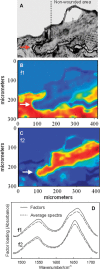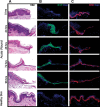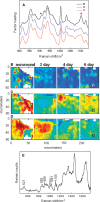A coordinated approach to cutaneous wound healing: vibrational microscopy and molecular biology
- PMID: 19145704
- PMCID: PMC4506178
- DOI: 10.1111/j.1582-4934.2008.00459.x
A coordinated approach to cutaneous wound healing: vibrational microscopy and molecular biology
Abstract
The repair of cutaneous wounds in the adult body involves a complex series of spatially and temporally organized processes to prevent infection and restore homeostasis. Three characteristic phases of wound repair (inflammation, proliferation including re-epithelialization and remodelling) overlap in time and space. We have utilized a human skin wound-healing model to correlate changes in genotype and pheno-type with infrared (IR) and confocal Raman spectroscopic images during the re-epithelialization of excisional wounds. The experimental protocols validated as IR images clearly delineate the keratin-rich migrating epithelial tongue from the collagen-rich wound bed. Multivariate statistical analysis of IR datasets acquired 6 days post-wounding reveal subtle spectral differences that map to distinct spatial distributions, which are correlated with immunofluorescent staining patterns of different keratin types. Images computed within collagen-rich regions expose complementary spatial patterns and identify elastin in the wound bed. The temporal sequence of events is explored through a comparison of gene array analysis with confocal Raman microscopy. Our approach demonstrates the feasibility of acquiring detailed molecular structure information from the various proteins and their subclasses involved in the wound-healing process.
Figures





References
-
- Coulombe PA. Wound epithelialization: accelerating the pace of discovery. J Invest Derinatol. 2003;121:219–30. - PubMed
-
- Singer AJ, Clark RAF. Cutaneous wound healing. NEngl JMed. 1999;341:738–46. - PubMed
-
- Freedberg IM, Tomic-Canic M, Komine M, Blumenberg M. Keratins and the ker-atinocyte activation cycle. J Invest Derinatol. 2001;116:633–40. - PubMed
Publication types
MeSH terms
Substances
Grants and funding
LinkOut - more resources
Full Text Sources
Other Literature Sources

